I hope you enjoy reading this blog post.
If you want to get more traffic, Contact Us

Click Here - Free 30-Minute Strategy Session
Be quick! FREE spots are almost gone for this Month. Free Quote

There was this friend of mine who tried to impress that special someone, and did everything he possibly could except taking her out to her favorite restaurant.
Dumb yeah?

Click Here – Free 30-Minute Strategy Session
Be quick! FREE spots are almost gone for this Month
Well, when it comes to the latest SEO techniques, missing out on semantic search is very similar.
Think of SEO as a way to impress the search engines.
You know what they like – highly relevant and specific keywords, great content that users find useful and informative, quality backlinks from high authority websites, etc. So you do all of these in the best possible way to try and grab their attention.
You know what they don’t like – keyword stuffing, irrelevant information, slow page-load speed, backlinks from bad sites, etc. So you refrain from these at all costs.
So far so good.
But hey, you are missing out on their favorite. SEMANTIC SEARCH!
Before I answer ‘What is semantic search?’, I’d like to give you a brief background about what’s happening up there in the Silicon Valley, and more importantly how semantic search came into being.
As you know by now, search engines, like any other piece of software, are based on immensely complex set of computer codes called algorithms.
And when written well, these codes can solve some of the most complex problems that humans face, including sending men out to moon and bringing them back.
However, can these codes strike up conversation with a human being? Smart engineers have been trying to answer this question for many years now.
And guess what, they have been very successful in understanding the fundamentals.
By trying to expand the realm of computer science into the field of artificial intelligence, these engineers are able to ‘train’ these computer codes to think like humans.
From personal digital assistants to algorithms that can play complex board games such as Go, engineers have always found ways to experiment their hypotheses on artificial intelligence.
And one of the applications of AI that has always been at the forefront of such experiments is the search engine.
Right from its initial days, Google has been implementing AI concepts to its search engine algorithm and over the years, semantic search and machine learning algorithms have become the core.
“Did you forget to add an attachment?”
Have you ever got this message before sending an email?
By scanning your email body, the email client was able to figure out that you were intending to add an attachment.
How? By simply looking for the word ‘attachment’ in your mail.
Rudimentary search engines operated in a similar way. They would manually scan a website’s content for keywords… with blinkers on. There was absolutely no regard whatsoever for the rest of the content.
Over the years, the engines have become far more sophisticated. Today, they are almost able to read content just like humans do.
The key to this progress is semantic search.
Broadly speaking, there are two branches of semantics.
The branch we are more concerned with is called the Lexical Semantics.
According to the Oxford dictionary, it is defined as “The analysis of word meanings and relations between them.”
By applying this concept, search engines are able to perform two important functions:
Firstly, they are able to accurately understand the user’s search intent based on the contextual meaning.
Secondly, they are able to scan the world wide web and come up the most relevant answers by analyzing, and not just scanning, the content of millions of websites.
So to summarize, semantic search involves exact understanding of a user’s search query and analyzing the web content to figure out the relevancy, both by applying the concept of Semantics.
From what we know thus far, it’s not hard to imagine why search engines would take the semantic search approach for better results.
It gives a more accurate understanding of the users’ search intent and thereby coming up with search results that are more conversational and natural.
Ultimately, the goal of search engines is to give the users the best possible search experience and semantic search attains this goal.
Just like the Moore’s law that predicted that the computational ability doubles every two years, data on the world wide web is also doubling every two years.
With big data analytics becoming the tool of choice for major players in the internet industry, search engines are relying on semantics more than ever to organize, structure, and connect data semantically.
One of the greatest challenges that search engines face is to identify and filter out low quality content.
With black hat techniques such as article spinning and keyword stuffing becoming rampant, advanced algorithms such as LSI (Latent Semantic Indexing), LDA (Latent Dirichlet Allocation), and TF-IDF (Term Frequency – Inverse Document Frequency) are making it easier for search engines to red flag such practices.
Modern search engines have a fair idea about how certain words are used together statistically are able to make semantic correlations.
This is making the afore mentioned black hat techniques almost obsolete
This gives the search engines a clear picture of what the users want.
Take a look at the pictorial representation of entity-based search algorithm.

The primary elements of this model are known as entities.
At the heart of semantic search is entity-based search.These can be people, ideas, places, concepts, and just about any similar attributes. These form the nodes of the model. All nodes are connected by arrows based on relationships between any two nodes.
The primary objective of entity-based search is to create as many connections as possible between the various entities. In this example, the objective is create relationships between various Simpson characters, their home town, place of work, pets, etc.

As you can see from the picture above, the search query “Where does Homer Simpson work” directs the search engine to look up the relationship between Homer and the Springfield Nuclear Reactor.
Another great example of how semantics help search engines to understand what exactly our search queries mean is illustrated below.
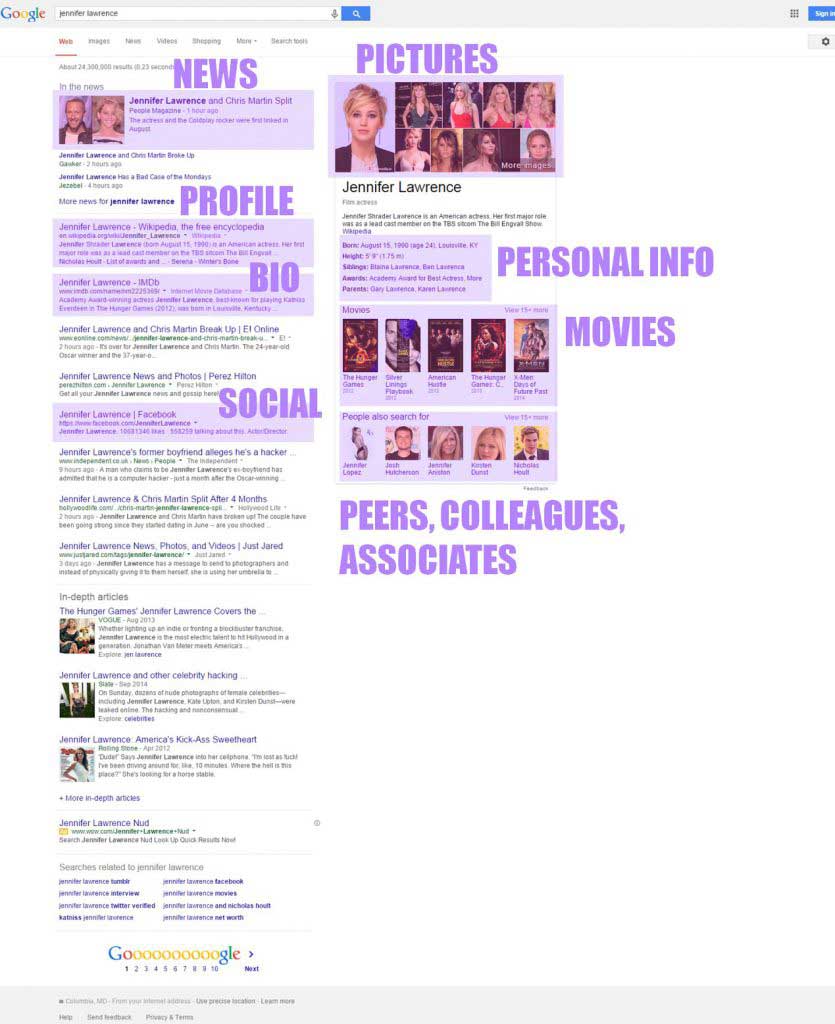
If you search for ‘Jennifer Lawrence’, a pretty common name, search engines will still know that you are searching for the American actress.
And it doesn’t stop at that. It will give you everything there is to know about her. Her pictures, films, co-stars, social media accounts, posts, tweets, and just about anything that’s related to her.
This is based on millions of search results that the engines tracked so the next time a user types in a search query, they know what exactly the user wants.
Google’s Knowledge Graph is a great example of how semantic search uses previous search results to understand user intent to come up with most relevant results.
Search engines have become so sophisticated that you don’t even need to enter the specific term within your search query to find out what you are looking for.
Consider this example.

Entity-based search enables Google to connect “Chandelier dance” with Maddie Ziegler. So your search queries are algorithmically understood and that makes the search more meaningful.
Any update to search engine algorithm, no matter how minor, will have its implications on how SEO specialists tweak their strategy.
And when the update is as huge as using semantic algorithms, it will have huge implications. So, if you want to stay ahead of the curve, you need to have a solid semantics-focused strategies in place.
It’s a well established fact within the SEO community that search engine algorithms are highly impenetrable. If we could understand all the concepts and logic involved, we could create the most optimum content for the page to rank number one.
However, there are time tested ways to understand how they work based on trial and error. And in the next section, you will learn about these specific strategies that will help you win the semantics game.
In the post semantic-search world, it’s all about providing greater value to your users by developing content that promotes a ‘conversation’. This was revealed by Sundar Pichai, CEO of Google, during the recent Google I/O.

To achieve this objective of Google Assistant having conversations with its users, Google needs a large repository of information from various sources – usually industry experts.
You must aim to become that source of information so Google can reference you in its conversations with its users.
You can provide immense value to your users by creating great content that is highly informative, relevant, and urgent.
Here are some of the recommendations to achieve that.
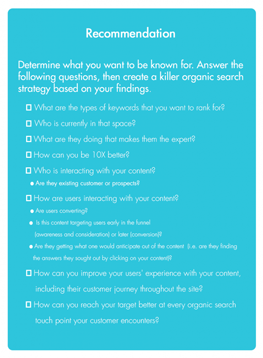
Creating highly targeted content that’s not aimed at branding or promotion should be your area of focus.
Think of all the questions that your customers might have about your industry and product-line. And come up with answers in a tone that’s conversational and natural.
Be sure not to create content that will cannibalize traffic away from your products or other important pages.
You should become an authoritative source of credible information that search engines can use.
Create robust content by using a variety of media – text, graphics, images, and videos.
Here are some of the recommendations to achieve this objective.
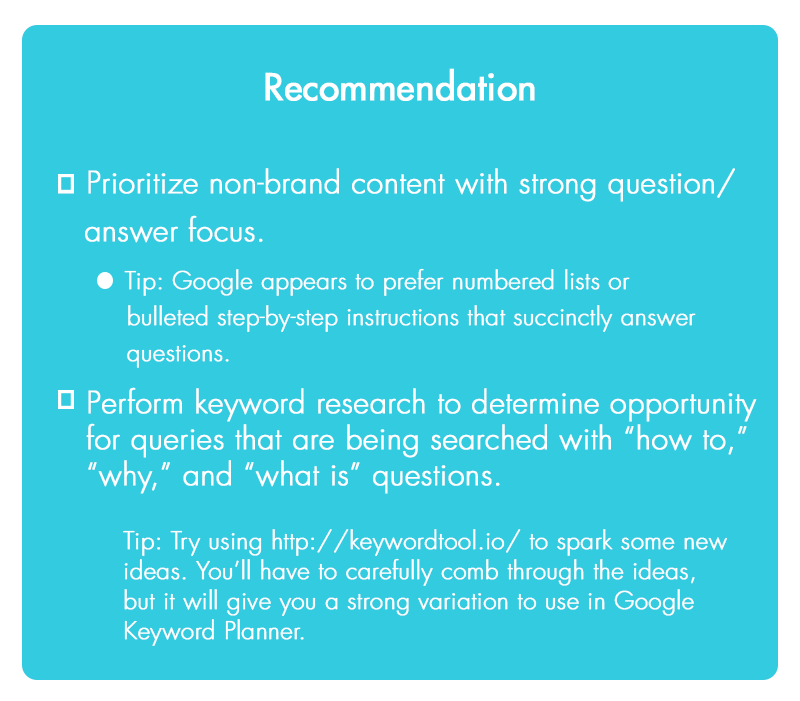
SEO writing has always been user-centric, and with semantic search promoting conversational style, this emphasis all the more evident.
The advent of semantic search in tandem with RankBrain and rising popularity of voice search means that you simply cannot afford to phrase your sentences in a natural, conversational way.
In a grammatical sense, you should focus on structuring your sentences in a noun-focused manner. This type of sentence structuring is more direct and search engines find it easier to extract information.
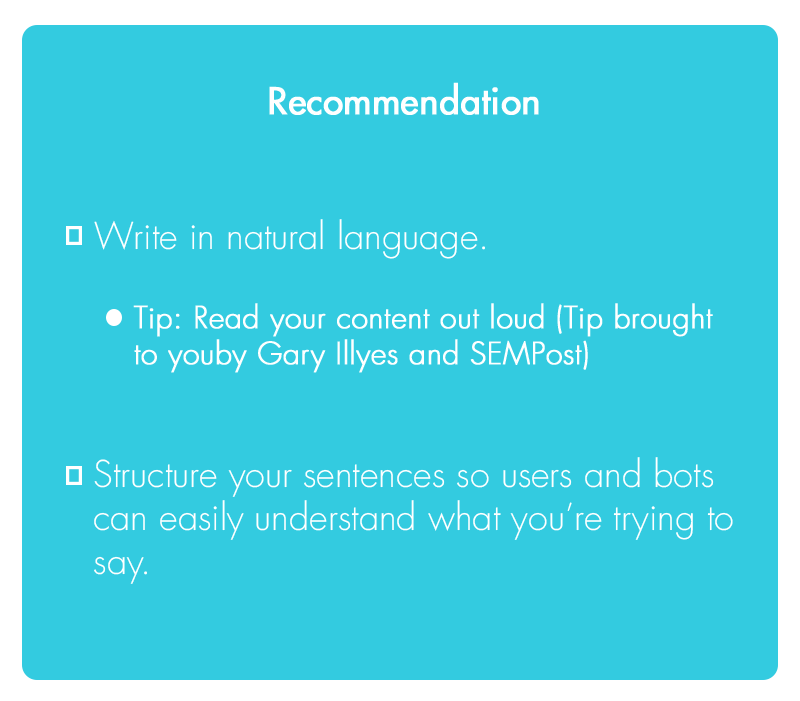
One template to follow is the Subject-Predicate-Object. This way you can always be sure that your sentences are direct.
Tip: Read your content out loud (Tip brought to you by Gary Illyes and SEMPost)
Nothing annotates information like structured data markup. It’s also a great way to signal search engines your intention of providing rich search results.
These snippets in turn offer a variety of additional information using multimedia elements such as graphics and videos.
Rich snippets are known to drastically improve click-through rates and contribute significantly towards your SEO endeavors.
Just make sure that your marked up data is presented on the page in a way that’s consistent with Google’s structured data policies. Also, keep yourself updated on Google’s active and in-use structured data markups.

In addition to helping your visitors navigate through your site effortlessly, internal linking also indicates topicality, which is what search engines love.
Just remember to use these links sparingly and only when you are sure that it adds value to your visitors.
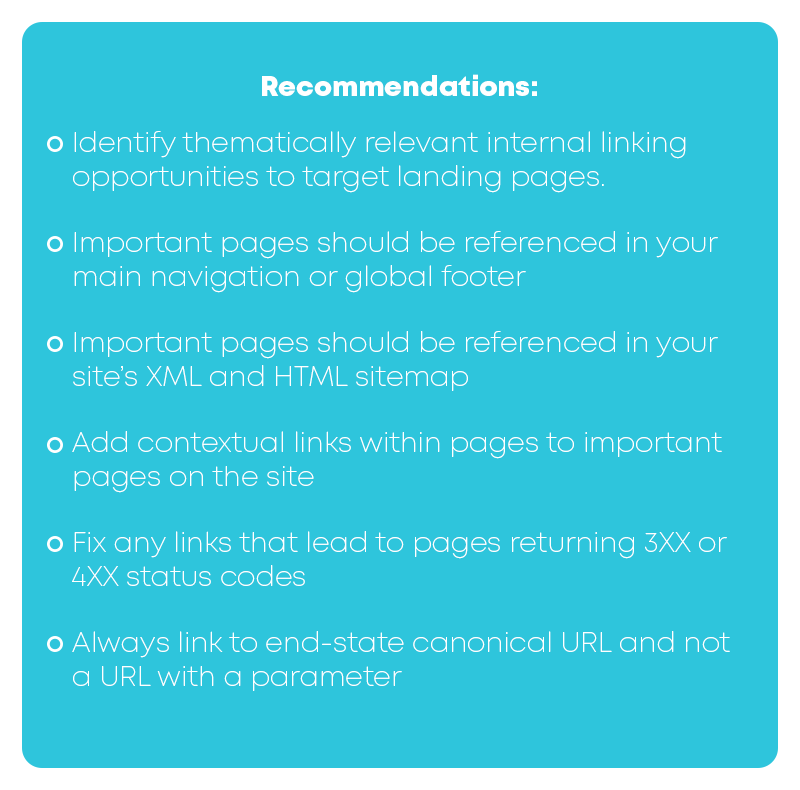
Semantic search is now at the heart of search engine algorithms and semantic signals are significantly affecting page ranks. As webmaster, you should adapt to these changes and include synonyms and other related terms to make your content rich in relevant information.
Semantic search involves advanced algorithms that identify and filter out content created via article spinning and other such black hat techniques. If your site contains such content, rewrite it as soon as you can.
Semantic search understands your user’s search intent algorithmically and therefore your content too should be created for engines to identify the answers in a similar way.

LEAVE A REPLY